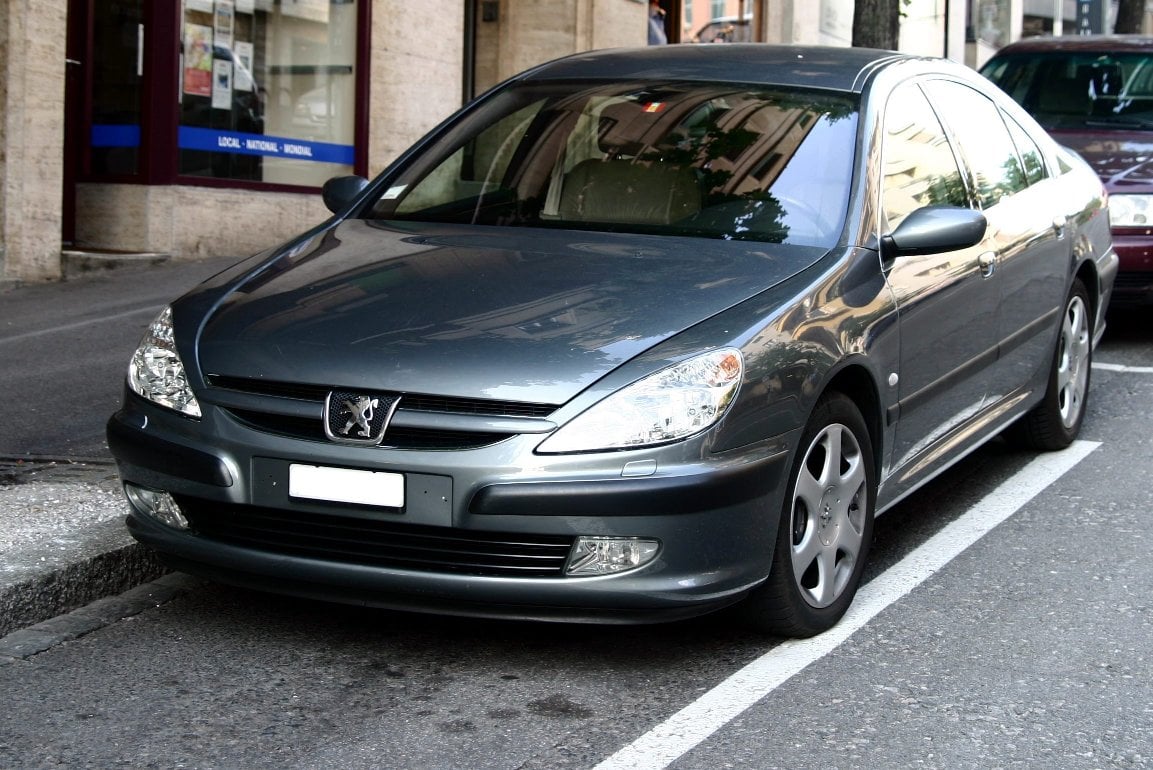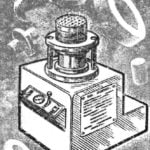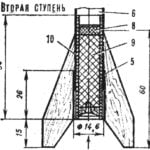 In the family of PEUGEOT has a car class. Your first car, Armand Peugeot in collaboration with Leon serpolle built in the nineteenth century — it was heavy and bulky three-wheeled carriage with a steam engine, which has not successfully exhibited at the world exhibition in Paris in 1889. And who knows what would be in the future fate of Armand Peugeot, the owner of a small Bicycle factory in Beaulieu, if he had not met at the exhibition with Emile Levasseur and Gottlieb Daimler.
In the family of PEUGEOT has a car class. Your first car, Armand Peugeot in collaboration with Leon serpolle built in the nineteenth century — it was heavy and bulky three-wheeled carriage with a steam engine, which has not successfully exhibited at the world exhibition in Paris in 1889. And who knows what would be in the future fate of Armand Peugeot, the owner of a small Bicycle factory in Beaulieu, if he had not met at the exhibition with Emile Levasseur and Gottlieb Daimler.
I must say that by the time the inventor of the petrol motor Daimler sold the license to manufacture its engine to France, where he was produced by the firm Panhard-Levassor.
Light and powerful enough engine made an impression on the young designer, and in the following year he built his first petrol PEUGEOT 2 engine Daimler, located in the rear part of the tubular frame of the machine. Motor with two V-shaped spaced cylinders had a displacement 0,565 l power: 2 HP Petrol firstborn Peugeot suited the taste of the customers and has enjoyed strong demand.
In 1896, Peugeot has sold his Bicycle factory and founded in the city of Audincourt company Peugeot started production twin-cylinder motor design Gratien Michaux. In 1899, Peugeot was able to sell 323 car fourteen different versions — by the time it was quite a lot!
In 1900, the company Peugeot launched the new PEUGEOT 31 the classical scheme — located in the front of the machine two-cylinder engine with 8 HP, followed by more powerful PEUGEOT 49 with four-cylinder 15-horsepower engine. Stage in the firm was the creation of a compact car PEUGEOT BEBE with a single-cylinder engine working volume 0,652 L.
In 1906, the firm Peugeot has released ten models with engine displacement from 1,817 to 9,755 L. In 1908 the firm was launched PEUGEOT 105 with a six-cylinder engine, the working volume of which amounted to 11,150 l (!).
In the same year, Robert Peugeot, a cousin of Armand Peugeot, the motorcycle plant in Beaulieu organised an independent production of compact low-cost cars under the brand name of LION PEUGEOT with a single cylinder engine working volume of 0,785 and 1,150 l. In 1910, the brothers have teamed up to create a Joint-stock company cars and bikes Peugeot (S. A. des automobiles et Cycles Peugeot) with the new big plant in Sochaux.
In 1913 the company started serial production of the new PEUGEOT BEBE — a simple and cheap machine with a four-cylinder engine working volume of 0,855 l, designed by the famous designer Ettore Bugatti.
Developed in the company and racing cars — in 1912-1914 powerful sports PEUGEOT won the Grand prize of France and the 500-mile race in Indianapolis (North America).

Double car PEUGEOT QUADRILETTE with an engine capacity of 9.5 HP and three-stage gearbox (1920)

Quadruple PEUGEOT 402 sedan with an engine capacity of 55 HP and three-stage gearbox (1937)

PEUGEOT 306, issued with three-, four – and five-door body with a hatchback, wagon and two-door convertible with engines ranging from 68 to 163 HP and five-speed transmission (1993)

PEUGEOT 406 coupe in the variant with engine capacity of 190 HP (1997). “406 th” was produced in the variants sedan and wagon engines from 90 to 194 HP

PEUGEOT 607 produced with engines from 136 to 210 HP and manual or automatic transmissions (2001)
After the First world war, the firm Peugeot has continued to produce pre-war models, and in 1920 created a easy and very affordable little car-PEUGEOT QUADRILETTE tandem with the engine capacity of 9,5 HP, in which the driver and the only passenger was located in a narrow case on an aircraft — each other. Three years later this model was replaced by the same PEUGEOT 172, and in 1925 — PEUGEOT 172ВС.
The firm Peugeot has actively expanded its activities in 1927, she acquired the company Bellanger and De Dion-Bouton and a year later released a few new cars, among which the most popular PEUGEOT 183 with a six-cylinder engine capacity of 1,122 L.
In 1930 the company released a head model a new, more modern series of cars — the PEUGEOT 201 with four-cylinder engine working volume of 1,122 l, as well as a number of its modifications with more powerful engines. And in 1936 was one of the most famous car company — sleek, streamlined PEUGEOT 402 with the headlights hidden behind the grille. Some of these machines were produced with diesel engines.
After the Second world war, the designers of the company started the development of a new car PEUGEOT 203. It was a very modern car with engine capacity of 1,290 litres, independent suspension on front wheels, rack and pinion steering and hydraulic braking system. The car was put into production in 1949. About the merits of the machine can be judged by the duration of its release — she was standing on the conveyor until the late 50-ies.
Well, the brainchild of the Peugeot continued to expand. To the above companies included in this automobile Empire, joined the firm of Hotchkiss, and Chenard-Walcker. In 1955, production was launched PEUGEOT 403, which became very popular in France and abroad. In 1960 it was replaced by the PEUGEOT 404, equipped with a gasoline (1.6 l) or diesel (1.8 l) engine.
In 60-ies the company released a runabout PEUGEOT 204 with a four-cylinder aluminum engine, with a displacement of 1.13 liters, which was located under the hood, transversely in unit with the gearbox. Replaced the PEUGEOT 204 PEUGEOT 304 is created with the more powerful 1.3-liter engine. But the most attractive model of the 60’s was a PEUGEOT 504 with engines working volume of 1.8 and 2.0 L.
In the 70-ies of the firm Peugeot, allying to itself the third largest French car company Citroën, was released in the first ranks of European car manufacturers. In the same decade, there was a merger with “gluttonous” and the European offices of the American concern Chrysler. The rapid development of the Peugeot was accompanied by the release of such famous cars as the PEUGEOT 604, an absolute leader in the production program of the company. The machine was equipped with six-cylinder V-engine cylinder capacity of 2,664 liters, created in conjunction with the companies Renault and Volvo. The same decade was marked by the mass production of very compact PEUGEOT 104, start of production of the PEUGEOT 305 1.3-liter engine and a subcompact car PEUGEOT 505.

Four-door front-wheel drive sedan PEUGEOT 607
In the early 80-ies of the firm faced a number of economic difficulties, but the launch of a series of very promising models of the PEUGEOT 205, which amounted to a tangible competition is very popular in Europe, the VW Golf was able to significantly improve the Affairs of the company. The PEUGEOT 205 was the undisputed survivor of world automotive engineering — without any upgrades it was produced until 1998.
In 1991, the company Peugeot has created the most compact your car — PEUGEOT 106 front-wheel drive with a transversely mounted engine, and in 1993 appeared on the market a PEUGEOT 306 — , three – or five-door compact car of the middle class. In the late 80-ies is not too popular Executive PEUGEOT 604 was replaced by a new and more successful sedan of PEUGEOT 605 with a range of engine displacement from 2 to Z l and a capacity of up to 194 HP But this machine did not meet expectations of the firm’s management — recently, the demand for this car was small.
The role of flagship firms today went to PEUGEOT 607. This front-wheel drive Executive sedan is offered as with petrol (row “four” V-shaped “six”) and diesel four-cylinder engine working volume of 2 to 3 liters.
The bodywork of the PEUGEOT 607 is a little different from the one that was its predecessor — the PEUGEOT 605. Improvements were made with the goal of reducing the mass (in particular, the hood of a new car made entirely of aluminium alloy), reducing the aerodynamic drag of the car (the “607-th” = 0,29) and increases passive safety. By the way, “607-th” is equipped with almost all the known systems of passive safety. In the cabin, six air bags: two front, two side and two window curtains that protect the heads of passengers in side impact or the coup. All seat belts — both front and rear — equipped with pre-tensioners and limiters tension. Inside door panels are the energy-absorbing cell liners.
Technical characteristics of family cars PEUGEOT 607

Radically changed compared to the PEUGEOT 605 car interior. Driver’s seat has five mechanical adjustments of its position and configuration, and some of the machines will have these adjustments with the servo. Harmonious lines of the front panels blend well with round dials, comfortable “easy grip” steering wheel with adjustment in two planes, a completely new design and functions of the Central console, which, in particular, made the controls climatic installation.
The design of the suspension of the PEUGEOT 607 is similar to that used on the “605-m”: front type “McPherson” with levers, mounted on a modified subframe and rear double wishbone. On models with four-cylinder engine uses gas shock absorbers low pressure (3 ATM), and on models with a V-shaped “six” installed deleteregkey adjustable gas shock absorbers high pressure (6 ATM) the Japanese firm Denso.
Diesel 2.2-liter four-cylinder engine with 160 HP was developed for the new machine on the basis of the motor, which was mounted on the models PEUGEOT 406 and PEUGEOT 206 S16. In addition to the increase in 0.2 l of its working volume and, consequently, the capacity, the firm was able to improve the thrust performance of the engine due to the regulated phases of the intake and electronic throttle and reduce vibrations through the use of balance shafts against obrashenie.
Three-liter V-shaped “six” is a modernized engine, first installed in the PEUGEOT 406 and PEUGEOT 605. After increasing the compression ratio (now it is 10.9) motor power has increased from 190 to 210 HP, and rework the intake tract made it less noisy.
For the new PEUGEOT 607 was developed turbodiesel with 136 HP and a working volume of 2.2 l In design it uses all the latest achievements in the production of diesel engines for cars: direct injection with Common rail system, Garrett turbocharger with variable geometry, which creates the boost to 1.1 bar, the system switching of vortex formation at the inlet depending on the frequency of rotation of the crankshaft and finally the balancer shafts of the compensatory. The engine has good traction characteristics.
To reduce exhaust smoke diesel equipped with a particulate filter installed after the oxidation catalyst and designed to trap particles of soot and unburned hydrocarbons. The filter is a ceramic honeycomb. When they every 400-500 kilometers clogged and the sensors will detect the pressure drop, the honeycomb burned exhaust gases heated up to 450 °C by injecting fuel-air mixture in the exhaust manifold. In addition to the successful regeneration of the filter to the fuel from a special tank additive is added to reduce the combustion temperature of soot. Content five-liter tank is enough for 80 thousand kilometers.

Lion logo Peugeot
It should be noted the view of many consumers, who believe that power 136 HP diesel engine and a 160-strong petrol “four” is clearly not enough for dynamic driving on polutoratonny car — especially on long climbs. However, the city claims to these motors and no — they all allow you to move on roads in a very active mode.
Machine with diesel engine is equipped with only a manual transmission, and cars with petrol engines — both mechanical and automatic transmissions. At the same time in computer memory auto box has 32 different switching algorithm, which allows to adapt it to any mode of movement.

The driver in the PEUGEOT 607

Purification system of exhaust gases:
1 — diesel particle filter; 2 — the gauge of pressure drop; 3 — engine control unit; 4 — tank with a regeneration composition; 5 — injection device of a regeneration composition; 6 — catalytic Converter; 7 — honeycomb particulate filter
Fundamentally different was the wiring: instead of beams of tens of wires on the vehicle uses multiplex wiring — four-wire bus by which information exchange with on-Board computer with devices and auxiliary devices. So, on-Board computer prevents the slip of the driven wheels and their failure to slide at sharp reset of gas, regulates the distribution of brake effort on axes, selects one of the nine modes adjustable shock absorbers. And when decelerating in excess of 7 m/S2 the computer itself turns on the alarm system. The machine runs the rain sensor in front behind the headlights automatically dims the interior mirror… Even the volume of the audio system of the computer increases with increasing speed and decreases the illumination devices and on-Board computer screen by reducing the light in the cabin.
In conclusion, it is worth noting that, according to specialists, the PEUGEOT 607 in terms of price and consumer qualities promises to be one of the best cars in its class. So, on the French market cost “607-th” will be from 30 to 36 thousand dollars, depending on the engine type.
I. EVSTRATOV



